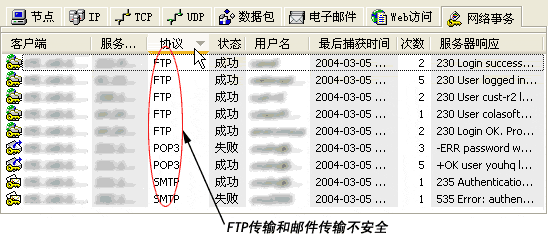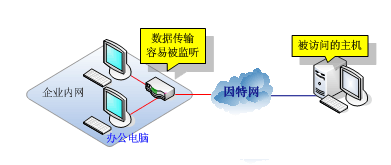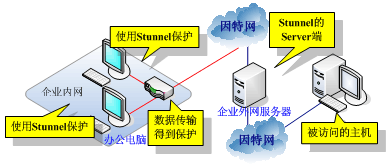stunnel使用详解
来源:互联网 发布:淘宝怎么只换货不退款 编辑:程序博客网 时间:2024/05/04 12:35
http://www.stunnel.org/faq/args.html
http://www.colasoft.com.cn/support/monitor_stunnel.php
科来网络分析系统与stunnel结合使用
科来网络分析系统是一款强大的网络检测分析工具,可对网络中未加密的数据传输进行检测分析并实时显示分析结果,包括用户的邮件收发、Web访问以及各种网络登录等操作。所以,未经加密的数据传输是不安全的,存在被别人窃听的安全隐患。
图一显示的是科来网络分析系统对网络数据传输捕获的结果,从中可以看出,当前网络中的敏感数据传输都未经过任何的加密保护,存在安全隐患。为加强网络本身的安全性,在使用科来网络分析系统进行网络管理的同时,我们建议用户对重要的数据传输进行加密保护,以达到管理和保护的有效结合。在这种情况下,即使数据被窃取,攻击者也无法分析数据的真实内容,从而保证了数据传输的安全性。

图一,网络事务分析结果

图二,普通网络
Stunnel (http://www.stunnel.org/)是一款可以加密网络数据的TCP连接,并可工作在Unix和Windows平台上,它采用Client/Server模式,将Client端的网络数据采用SSL(Secure Sockets Layer)加密后,安全的传输到指定的Server端再进行解密还原,然后再发送到访问的服务器。在加密传输过程中,可充分确保数据的安全性,我们只要把Server端程序安装在局域网外面的一台服务器上,即可保证传输的数据在局域网内是安全的,如图三所示。

图三,Stunnel加密后的网络
操作过程:
Stunnel是一款免费的工具,可以在这里下载。下面我们介绍一下具体的使用。- 下载Stunnel Client端程序,并解压到本机的C:/Program Files目录下。
- 下载Stunnel Server端程序,并解压后放在外网的服务器上。
- 分别配置stunnel.conf文件。
- 更改本机应用程序的网络连接配置。
- 分别运行stunnel.-4.04.exe执行文件。
我们使用Stunnel,需要在外网有一台有管理权限的服务器,来运行Stunnel的Server程序。配置好Stunnel.conf后,可将执行文件在启动菜单中建立快捷方式,这样让每次开机时,能自动运行。Stunnel技术是将传输的信息加密后,通过Server端的服务器进行解密才到达的目的主机,所以在选择Server端服务器的时候,对服务器的带宽速度有一定的要求。
Stunnel的配置:
Client和Server端都包含stunnel.conf配置文件,格式如下表所示:Client端stunnel.conf文件内容 Server端stunnel.conf文件内容# Use it for client mode
client = yes
#Client-level configuration
[ 应用服务名称 ]
accept =本地IP : 目标端口
connect =Server端IP : 指定的端口 # Use it for server mode
client = no
#Server-level configuration
[ 应用服务名称 ]
accept = 指定的端口
connect =目标服务器IP : 目标端口
常见应用实例:
Stunnel.conf文件配置比较简单,下面我们介绍一些常见应用配置,其中Client端是放在本机,IP是127.0.0.1,Server端是放在外网的服务器上,IP是202.151.90.28。1.加密邮件传输:
加密邮件,需要将发送和接收的过程都要进行保护,那么我们就要对POP3和SMTP传送方式进行加密。如果我们有一个xxx@colasoft.com.cn信箱,服务器的IP是202.108.44.153,配置文件stunnel.conf如下:Client端SMTP和POP3文件内容 Server端SMTP和POP3文件内容 [smtp.colasoft.com.cn]
accept = 127.0.0.1:25
connect = 202.151.90.28:125
[pop3.colasoft.com.cn]
accept = 127.0.0.1:110
connect = 202.151.90.28:1110 [smtp.colasoft.com.cn]
accept = 125
connect = 202.108.44.170:25
[pop3.colasoft.com.cn]
accept = 1110
connect = 202.108.44.153:110
如果有多个邮件传输需要加密,则增加相应的POP3和SMTP设置即可。设置好了配置文件,我们还需要将邮件客户端(常见的为Foxmail或Outlook)与其对应,设置如下:
发送的邮件地址改为:127.0.0.1 端口改为:125
接收的邮件地址改为:127.0.0.1 端口改为:1110
2.加密FTP传输:
FTP是比较早的文件传输协议,内容都是以明文方式传输,我们利用Stunnel后,也可以让FTP的传输非常安全,现在我们只需要在前面的stunnel.conf内容里面增加以下配置信息:Client端FTP的配置 Server端FTP的配置 [ftp.net130.com]
accept = 127.0.0.1:21
connect = 202.151.90.28:121 [ftp.net130.com]
accept = 121
connect = 218.7.9.73:21
FTP软件(如CuteFTP)也要做相应更改:
登录的远程地址改为:127.0.0.1 端口改为121
3.加密HTTP网站访问传输:
我们不能对所有的网站访问都进行加密,因为太多,但对于很重要的网站,我们也可以用Stunnel来保护访问的内容不受到监听。例如我们要访问www.colasoft.com.cn,网站IP地址是202.108.36.172,HTTP的配置如下:Client端HTTP的配置 Server端HTTP的配置 [www.colasoft.com.cn]
accept = 127.0.0.1:80
connect = 202.151.90.28:8080 [www.colasoft.com.cn]
accept = 8080
connect = 202.108.36.172:80
通过结合使用科来网络分析系统与Stunnel,既可以做到对网络的安全检测,并找出网络内的潜在安全隐患,又能从防护的角度出发,保护公司内部网络的重要信息。此方案成本低,不改变当前网络内的结构,容易实施,是一个简单有效的安全管理方案。
Stunnel-4.10 Man Page
- NAME
- SYNOPSIS
- DESCRIPTION
- OPTIONS
- CONFIGURATION FILE
- GLOBAL OPTIONS
- SERVICE-LEVEL OPTIONS
- RETURN VALUE
- EXAMPLES
- FILES
- BUGS
- RESTRICTIONS
- NOTES
- INETD MODE
- CERTIFICATES
- RANDOMNESS
- SEE ALSO
- AUTHOR
NAME
stunnel - universal SSL tunnel
SYNOPSIS
- Unix:
- stunnel [<filename>] | -fd n | -help | -version | -sockets
- WIN32:
- stunnel [ [-install | -uninstall] [-quiet] [<filename>] ] | -help | -version | -sockets
DESCRIPTION
The stunnel program is designed to work as SSL encryption wrapper between remote clients and local (inetd-startable) or remote servers. The concept is that having non-SSL aware daemons running on your system you can easily set them up to communicate with clients over secure SSL channels.
stunnel can be used to add SSL functionality to commonly used Inetd daemons like POP-2, POP-3, and IMAP servers, to standalone daemons like NNTP, SMTP and HTTP, and in tunneling PPP over network sockets without changes to the source code.
This product includes cryptographic software written by Eric Young (eay@cryptsoft.com)
OPTIONS
- <filename>
- Use specified configuration file
- -fd n (Unix only)
- Read the config file from specified file descriptor
- -help
- Print stunnel help menu
- -version
- Print stunnel version and compile time defaults
- -sockets
- Print default socket options
- -install (NT/2000/XP only)
- Install NT Service
- -uninstall (NT/2000/XP only)
- Uninstall NT Service
- -quiet (NT/2000/XP only)
- Don't display a message box when successfully installed or uninstalled NT service
CONFIGURATION FILE
Each line of the configuration file can be either:
- an empty line (ignored)
- a comment starting with ';' (ignored)
- an 'option_name = option_value' pair
- '[service_name]' indicating a start of a service definition
GLOBAL OPTIONS
- CApath = directory
- Certificate Authority directory
This is the directory in which stunnel will look for certificates when using the verify. Note that the certificates in this directory should be named XXXXXXXX.0 where XXXXXXXX is the hash value of the cert.
CApath path is relative to chroot directory if specified.
- CAfile = certfile
- Certificate Authority file
This file contains multiple CA certificates, used with the verify.
- cert = pemfile
- certificate chain PEM file name
A PEM is always needed in server mode. Specifying this flag in client mode will use this certificate chain as a client side certificate chain. Using client side certs is optional. The certificates must be in PEM format and must be sorted starting with the certificate to the highest level (root CA).
- chroot = directory (Unix only)
- directory to chroot stunnel process
chroot keeps stunnel in chrooted jail. CApath, CRLpath, pid and exec are located inside the jail and the patches have to be relative to the directory specified with chroot.
To have libwrap (TCP Wrappers) control effective in a chrooted environment you also have to copy its configuration files (/etc/hosts.allow and /etc/hosts.deny) there.
- ciphers = cipherlist
- Select permitted SSL ciphers
A colon delimited list of the ciphers to allow in the SSL connection. For example DES-CBC3-SHA:IDEA-CBC-MD5
- client = yes | no
- client mode (remote service uses SSL)
default: no (server mode)
- compression = zlib | rle
- select data compression algorithm
default: no compression
- CRLpath = directory
- Certificate Revocation Lists directory
This is the directory in which stunnel will look for CRLs when using the verify. Note that the CRLs in this directory should be named XXXXXXXX.0 where XXXXXXXX is the hash value of the CRL.
CRLpath path is relative to chroot directory if specified.
- CRLfile = certfile
- Certificate Revocation Lists file
This file contains multiple CRLs, used with the verify.
- debug = [facility.]level
- debugging level
Level is a one of the syslog level names or numbers emerg (0), alert (1), crit (2), err (3), warning (4), notice (5), info (6), or debug (7). All logs for the specified level and all levels numerically less than it will be shown. Use debug = debug or debug = 7 for greatest debugging output. The default is notice (5).
The syslog facility 'daemon' will be used unless a facility name is supplied. (Facilities are not supported on Win32.)
Case is ignored for both facilities and levels.
- EGD = egd path (Unix only)
- path to Entropy Gathering Daemon socket
Entropy Gathering Daemon socket to use to feed OpenSSL random number generator. (Available only if compiled with OpenSSL 0.9.5a or higher)
- engine = auto | <engine id>
- select hardware engine
default: software-only cryptography
- foreground = yes | no (Unix only)
- foreground mode
Stay in foreground (don't fork) and log to stderr instead of via syslog (unless output is specified).
default: background in daemon mode
- key = keyfile
- private key for certificate specified with cert option
Private key is needed to authenticate certificate owner. Since this file should be kept secret it should only be readable to its owner. On Unix systems you can use the following command:
chmod 600 keyfile
default: value of cert option
- options = SSL_options
- OpenSSL library options
The parameter is the OpenSSL option name as described in the SSL_CTX_set_options(3ssl) manual, but without SSL_OP_ prefix. Several options can be used to specify multiple options.
For example for compatibility with erroneous Eudora SSL implementation the following option can be used:
options = DONT_INSERT_EMPTY_FRAGMENTS
- output = file
- append log messages to a file instead of using syslog
/dev/stdout device can be used to redirect log messages to the standard output (for example to log them with daemontools splogger).
- pid = file (Unix only)
- pid file location
If the argument is empty, then no pid file will be created.
pid path is relative to chroot directory if specified.
- RNDbytes = bytes
- bytes to read from random seed files
Number of bytes of data read from random seed files. With SSL versions less than 0.9.5a, also determines how many bytes of data are considered sufficient to seed the PRNG. More recent OpenSSL versions have a builtin function to determine when sufficient randomness is available.
- RNDfile = file
- path to file with random seed data
The SSL library will use data from this file first to seed the random number generator.
- RNDoverwrite = yes | no
- overwrite the random seed files with new random data
default: yes
- service = servicename
- use specified string as the service name
On Unix: inetd mode service name for TCP Wrapper library.
On NT/2000/XP: NT service name in the Control Panel.
default: stunnel
- session = timeout
- session cache timeout
- setgid = groupname (Unix only)
setgid()to groupname in daemon mode and clears all other groups- setuid = username (Unix only)
setuid()to username in daemon mode- socket = a|l|r:option=value[:value]
- Set an option on accept/local/remote socket
The values for linger option are l_onof:l_linger. The values for time are tv_sec:tv_usec.
Examples:
socket = l:SO_LINGER=1:60 set one minute timeout for closing local socket socket = r:TCP_NODELAY=1 turn off the Nagle algorithm for remote sockets socket = r:SO_OOBINLINE=1 place out-of-band data directly into the receive data stream for remote sockets socket = a:SO_REUSEADDR=0 disable address reuse (enabled by default) socket = a:SO_BINDTODEVICE=lo only accept connections on loopback interface
- taskbar = yes | no (WIN32 only)
- enable the taskbar icon
default: yes
- verify = level
- verify peer certificate
level 1 - verify peer certificate if present level 2 - verify peer certificate level 3 - verify peer with locally installed certificate default - no verify
SERVICE-LEVEL OPTIONS
Each configuration section begins with service name in square brackets. The service name is used for libwrap (TCP Wrappers) access control and lets you distinguish stunnel services in your log files.
Note that if you wish to run stunnel in inetd mode (where it is provided a network socket by a server such as inetd, xinetd, or tcpserver) then you should read the section entitled INETD MODE below.
- accept = [host:]port
- accept connections on specified host:port
If no host specified, defaults to all IP addresses for the local host.
- connect = [host:]port
- connect to remote host:port
If no host specified, defaults to localhost.
- delay = yes | no
- delay DNS lookup for 'connect' option
- exec = executable_path (Unix only)
- execute local inetd-type program
exec path is relative to chroot directory if specified.
- execargs = $0 $1 $2 ... (Unix only)
- arguments for exec including program name ($0)
Quoting is currently not supported. Arguments are separated with arbitrary number of whitespaces.
- ident = username
- use IDENT (RFC 1413) username checking
- local = host
- IP of the outgoing interface is used as source for remote connections. Use this option to bind a static local IP address, instead.
- protocol = proto
- Negotiate SSL with specified protocol
currently supported: cifs, nntp, pop3, smtp
- pty = yes | no (Unix only)
- allocate pseudo terminal for 'exec' option
- TIMEOUTbusy = seconds
- time to wait for expected data
- TIMEOUTclose = seconds
- time to wait for close_notify (set to 0 for buggy MSIE)
- TIMEOUTconnect = seconds
- time to wait to connect a remote host
- TIMEOUTidle = seconds
- time to keep an idle connection
- transparent = yes | no (Unix only)
- transparent proxy mode
Re-write address to appear as if wrapped daemon is connecting from the SSL client machine instead of the machine running stunnel. This option is only available in local mode (exec option) by LD_PRELOADing env.so shared library or in remote mode (connect option) on Linux 2.2 kernel compiled with transparent proxy option and then only in server mode. Note that this option will not combine with proxy mode (connect) unless the client's default route to the target machine lies through the host running stunnel, which cannot be localhost.
RETURN VALUE
stunnel returns zero on success, non-zero on error.
EXAMPLES
In order to provide SSL encapsulation to your local imapd service, use
[imapd] accept = 993 exec = /usr/sbin/imapd execargs = imapd
If you want to provide tunneling to your pppd daemon on port 2020, use something like
[vpn] accept = 2020 exec = /usr/sbin/pppd execargs = pppd local pty = yes
If you want to use stunnel in inetd mode to launch your imapd process, you'd use this stunnel.conf. Note there must be no [service_name] section.
exec = /usr/sbin/imapd execargs = imapd
FILES
- stunnel.conf
- stunnel configuration file
- stunnel.pem
- stunnel certificate and private key
BUGS
Option execargs does not support quoting.
RESTRICTIONS
stunnel cannot be used for the FTP daemon because of the nature of the FTP protocol which utilizes multiple ports for data transfers. There are available SSL enabled versions of FTP and telnet daemons, however.
NOTES
INETD MODE
The most common use of stunnel is to listen on a network port and establish communication with either a new port via the connect option, or a new program via the exec option. However there is a special case when you wish to have some other program accept incoming connections and launch stunnel, for example with inetd, xinetd, or tcpserver.
For example, if you have the following line in inetd.conf:
imaps stream tcp nowait root /usr/sbin/stunnel stunnel /etc/stunnel/imaps.conf
In these cases, the inetd-style program is responsible for binding a network socket (imaps above) and handing it to stunnel when a connection is received. Thus you do not want stunnel to have any accept option. All the Service Level Options should be placed in the global options section, and no [service_name] section will be present. See the EXAMPLES section for example configurations.
CERTIFICATES
Each SSL enabled daemon needs to present a valid X.509 certificate to the peer. It also needs a private key to decrypt the incoming data. The easiest way to obtain a certificate and a key is to generate them with the free OpenSSL package. You can find more information on certificates generation on pages listed below.
Two things are important when generating certificate-key pairs for stunnel. The private key cannot be encrypted, because the server has no way to obtain the password from the user. To produce an unencrypted key add the -nodes option when running the req command from the OpenSSL kit.
The order of contents of the .pem file is also important. It should contain the unencrypted private key first, then a signed certificate (not certificate request). There should be also empty lines after certificate and private key. Plaintext certificate information appended on the top of generated certificate should be discarded. So the file should look like this:
-----BEGIN RSA PRIVATE KEY----- [encoded key] -----END RSA PRIVATE KEY----- [empty line] -----BEGIN CERTIFICATE----- [encoded certificate] -----END CERTIFICATE----- [empty line]
RANDOMNESS
stunnel needs to seed the PRNG (pseudo random number generator) in order for SSL to use good randomness. The following sources are loaded in order until sufficient random data has been gathered:
- The file specified with the RNDfile flag.
- The file specified by the RANDFILE environment variable, if set.
- The file .rnd in your home directory, if RANDFILE not set.
- The file specified with '--with-random' at compile time.
- The contents of the screen if running on Windows.
- The egd socket specified with the EGD flag.
- The egd socket specified with '--with-egd-sock' at compile time.
- The /dev/urandom device.
With recent (>=OpenSSL 0.9.5a) version of SSL it will stop loading random data automatically when sufficient entropy has been gathered. With previous versions it will continue to gather from all the above sources since no SSL function exists to tell when enough data is available.
Note that on Windows machines that do not have console user interaction (mouse movements, creating windows, etc) the screen contents are not variable enough to be sufficient, and you should provide a random file for use with the RNDfile flag.
Note that the file specified with the RNDfile flag should contain random data -- that means it should contain different information each time stunnel is run. This is handled automatically unless the RNDoverwrite flag is used. If you wish to update this file manually, the openssl rand command in recent versions of OpenSSL, would be useful.
One important note -- if /dev/urandom is available, OpenSSL has a habit of seeding the PRNG with it even when checking the random state, so on systems with /dev/urandom you're likely to use it even though it's listed at the very bottom of the list above. This isn't stunnel's behaviour, it's OpenSSLs.
SEE ALSO
- tcpd(8)
- access control facility for internet services
- inetd(8)
- internet 'super-server'
- http://stunnel.mirt.net/http://stunnel.mirt.net/
- stunnel homepage
- http://www.stunnel.org/http://www.stunnel.org/
- stunnel Frequently Asked Questions
- http://www.openssl.org/http://www.openssl.org/
- OpenSSL project website
AUTHOR
- Michal Trojnara
<Michal.Trojnara@mirt.net>
The Ubiquitous Miscellaneous Section
Those things that don't have a proper home yet may end up here. Or they may stay here. I've heard that many answers prefer to be in the miscellaneous sections. Maybe they're just shy.
What are the offical SSL ports?
These are the officially 'registered' ports for various SSL-ified protocols. note that listing them here doesn't mean that they can be used with stunnel.
nsiiops 261/tcp # IIOP Name Service over TLS/SSL https 443/tcp # http protocol over TLS/SSL smtps 465/tcp # smtp protocol over TLS/SSL (was ssmtp) nntps 563/tcp # nntp protocol over TLS/SSL (was snntp) imap4-ssl 585/tcp # IMAP4+SSL (use 993 instead) sshell 614/tcp # SSLshell ldaps 636/tcp # ldap protocol over TLS/SSL (was sldap) ftps-data 989/tcp # ftp protocol, data, over TLS/SSL ftps 990/tcp # ftp protocol, control, over TLS/SSL telnets 992/tcp # telnet protocol over TLS/SSL imaps 993/tcp # imap4 protocol over TLS/SSL ircs 994/tcp # irc protocol over TLS/SSL pop3s 995/tcp # pop3 protocol over TLS/SSL (was spop3) msft-gc-ssl 3269/tcp # Microsoft Global Catalog with LDAP/SSL
How do I know which encryption ciphers are available?
The ciphers that are availabre to stunnel (and usable by the '-C' flag) are determined by your OpenSSL library. To list the available ciphers, run the following:
openssl ciphers -v
How can I delay DNS lookups until connect time?
If you're using Stunnel-4.0 or later, add the following to your Stunnel configuration file:
delay = yes
If you are using older versions, there are several different patches available for this in the patches directory on this site you may try.
Another option is to launch redir (a TCP redirector) dynamically instead of using the "-r host:port" option, like this:
-l /usr/bin/redir -- redir --inetd --caddr host --cport port
How can I convert a certificate from der format (.cer) to PEM format?
Some institutions that supply certificates will send them to you in der format instead of PEM format. You can use the openssl command line tool to convert from one to the other:
openssl x509 -in file.cer -inform d -out file.pem
- stunnel使用详解
- Stunnel使用详解
- 使用 Stunnel 加密
- stunnel客户端的使用
- Stunnel 编译及使用
- 使用 Stunnel 建立加密隧道
- Stunnel 的配置和使用
- stunnel加密通道使用实践
- 使用stunnel加密普通TCP连接
- linux下使用Stunnel配置与使用方式一例
- 使用windows stunnel 客户端连接 squid https 代理
- raspberry p2上使用OpenVPN和Stunnel搭建VPN
- 使用stunnel双向证书认证加密samba的数据传输
- Linux下使用Stunnel加密Redis,实现ssl认证
- CentOS上使用Squid+Stunnel搭建代理服务器教程
- 使用加密的squid配合stunnel实现HTTP代理
- stunnel安装
- stunnel点滴
- 通用表单验证函数
- 修练8年C++面向对象程序设计之体会2
- 6.timeSetEvent
- 7.GetTickCount
- 8.timeGetTime
- stunnel使用详解
- Microsoft操作系统远程管理实施方案(绿盟)
- 9.GetSystemTime
- 10.GetLocalTime
- How to Copy an Entire Directory in VB6?
- 函数对象的函数适配器
- C++程序员快速学习C#---(三)完
- 转载:程序开机启动
- C# 编码规范和编程好习惯[转载]


